Since December 2019, I have been visiting Saul Kere regularly to watch birds. I have recorded about 170 species of the 200 or more seen by birders here. In addition, I have led some of the BngBirds First Sunday walks and I have become part of a warm and welcoming community of ardent nature lovers to whom I am immensely grateful for surviving the bleak days of the pandemic.
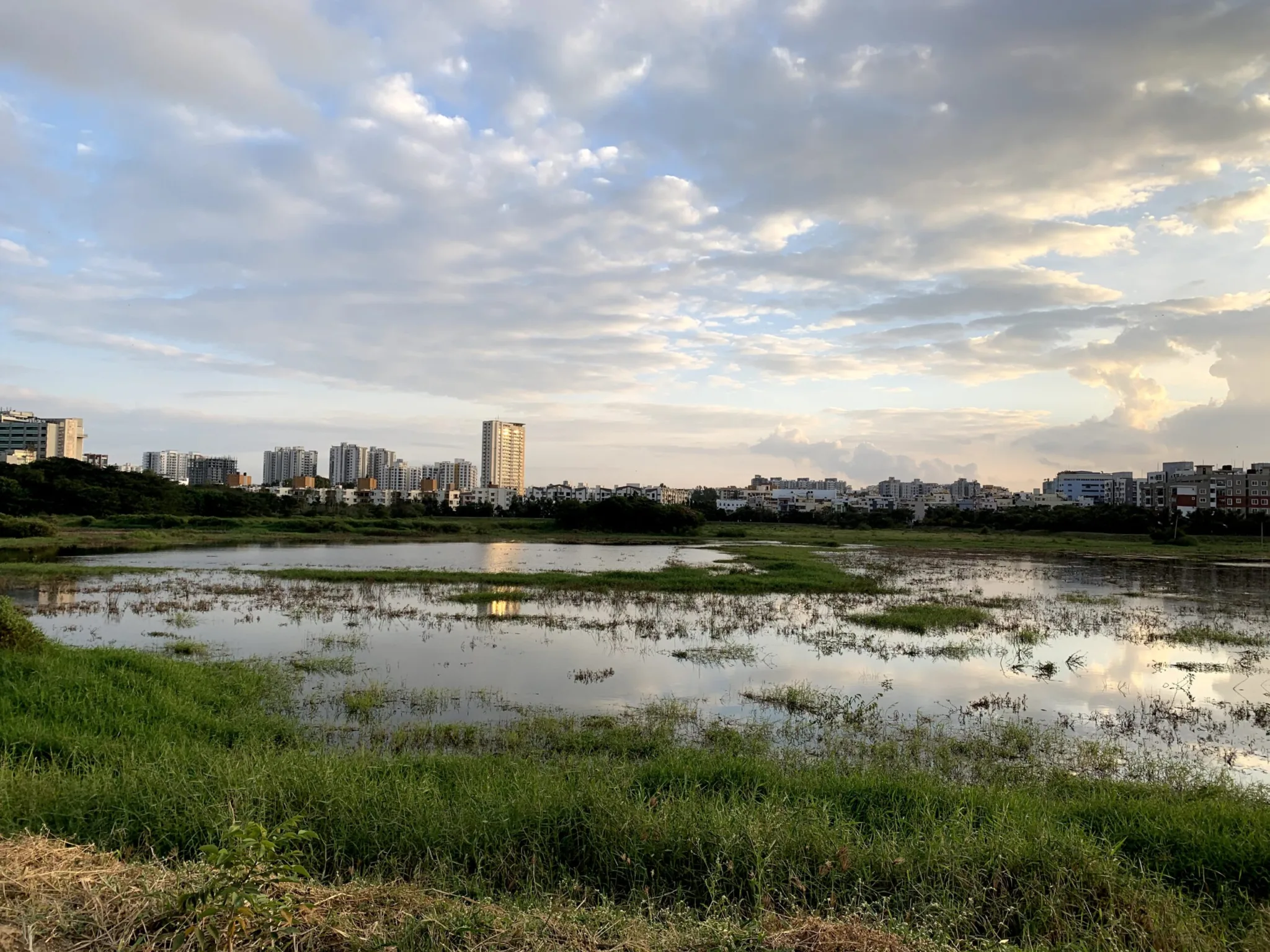
The September 2022 floods that ravaged Bangalore turned the public eye on the city’s lakes, which had allegedly contributed to the flooding. In fact, the channels connecting these water bodies, known as raja kaluves, have been encroached upon by builders with the complicity of the authorities, and that was the root cause of the poorly managed overflow. However, this being an election year in Karnataka, the political swish set has swung into action to create optical impact.

In late 2022, we observed flex banners bearing the picture of the local MLA declaring that civil works were coming soon to Saul Kere. And that’s where this story unfolds.
Saul Kere – the story so far
Saul Kere (variably denoted as Sowl Kere or Soul Kere; Kannada ಸಾವಳ ಕೆರೆ), is a medium-sized urban wetland in Bengaluru’s Bellandur-Kaikondrahalli area measuring about 23 Ha. It is administered by the Lakes department of Bruhat Bengaluru Mahanagara Palike (BBMP), the municipal body responsible for maintenance of the urban lakes in the Bengaluru municipal area. Saul Kere is downstream from Kaikondrahalli Kere and upstream from Bellandur Kere, two major urban lakes, and is connected to both by a Raja Kaluve — a traditional overflow channel linking water bodies to control flooding. The name of the lake, corrupted to Soul or Saul, derives from the Kannada word Saawala (ಸಾವಳ), meaning clay, and may be a reference to the natural soil of the lake bed.

Nature enthusiasts consider Saul Kere to be one of the richest biodiversity areas in urban Bengaluru. In addition to being a publicly accessible recreational green lung for all citizens including walkers and joggers, it is treasured by the city’s birdwatching community as a birding hotspot with over 205 recorded bird species (as per eBird public data from more than 2,800 checklists) in addition to thousands of other taxa like insects and other arthropods, reptiles, amphibians, small mammals, as well as a variety of fungi, flowering plants, and trees documented on the citizen science portal iNaturalist.
For perspective, it’s important to consider this rich avian diversity in comparison to some of Karnataka’s most celebrated bird sanctuaries, such as Ranganathittu (230 species), Mandagadde (110 species) and Ghataprabha (96 species).
You can choose to make Saul Kere a bird-friendly lake
As citizens, we must direct the administration to take cognisance of this rich avian diversity in the heart of urban Bengaluru, and take immediate steps to protect and maintain this wetland ecosystem in ways that ensure its continuity and utility as a public commons for all stakeholders.
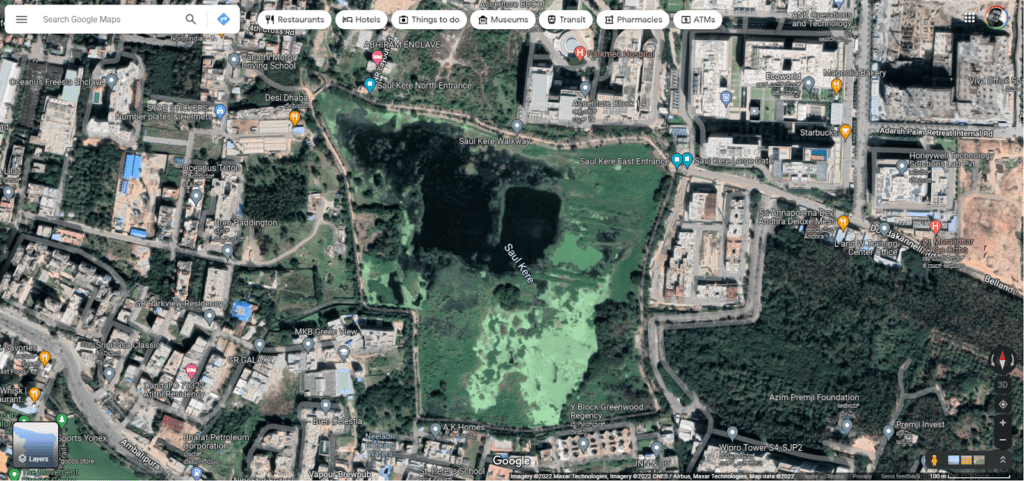
While controlling encroachment and pollution, increasing catchment and storage capacity to prevent flooding are imperative, any current or future lake maintenance or development steps must keep in mind ecological considerations for the conservation of biodiversity at this wetland and enshrine it as a model for urban wetland conservation.
Bird diversity at Saul Kere
The presence of birds in an ecosystem is a vital indicator of its health. Birds are important agents of insect and rodent control, plant pollination, and seed dispersal, which result in tangible benefits to human populations. Observing birds is also a recreational pursuit that is fast catching on, helping citizens appreciate the role of birds in the ecosystem, stoking curiosity and delight about their beauty, behaviour and habitats, and creating awareness that builds up to conscious environmental impact decisions and climate change action. In fact, during the COVID-19 pandemic, the number of people locked down at home started watching birds from their balconies or yards, and birding as a leisure pursuit grew substantially in popularity. The accessibility and popularity of the eBird app and platform has also contributed significantly to the increased interest in birding.
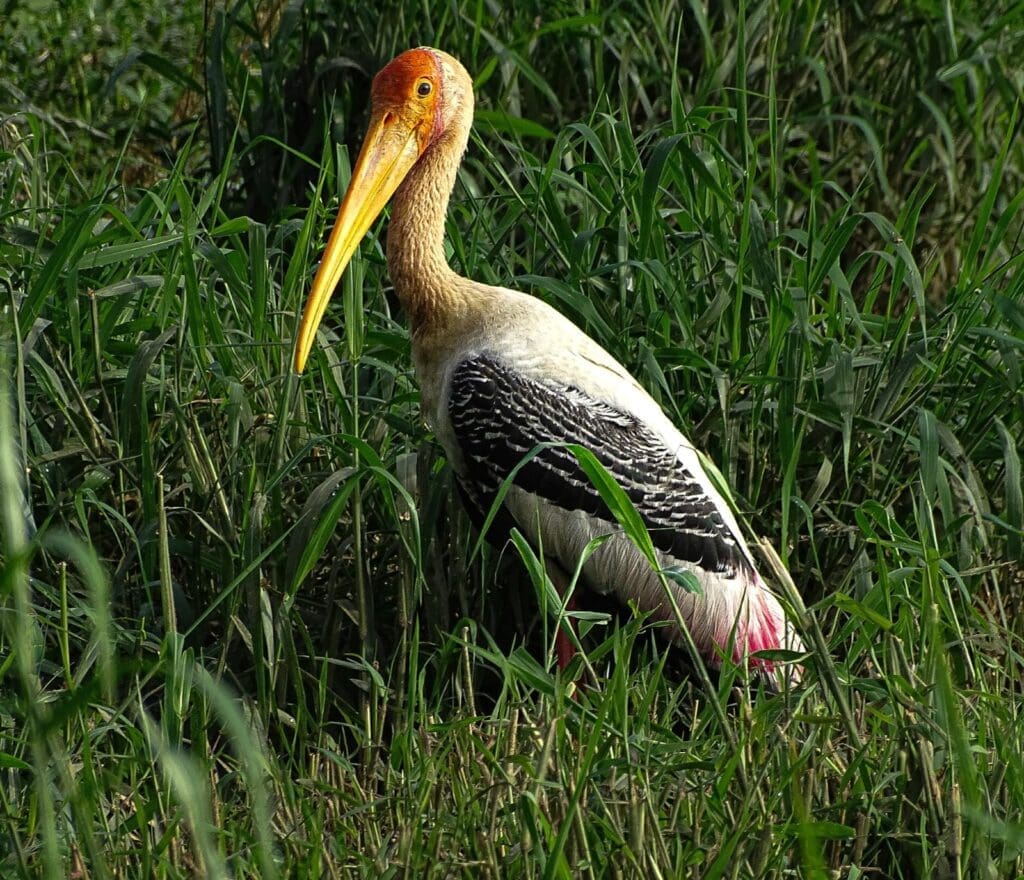
Each day, birders document between 25 and 50 species of birds on average at Saul Kere. The winter months (from early September to early April) see this number growing by about 30%-35%. From more than 2,200 eBird checklists made by birders at the lake, an estimated 205 or more species have been documented, many of them shown to be breeding seasonally or throughout the year at this location. During the first Sunday Bird Walks conducted by Bngbirds, the oldest and largest group of birdwatching enthusiasts in the city, observers have documented more than 65-75 species of birds in a single outing at Saul Kere. This is demonstrative of the richness of bird life at this urban lake that thrives due to the availability of multiple microhabitats that can support this biodiversity.
A sanctuary for migratory birds
The wetlands of peninsular India, including those in Bengaluru, fall within the migratory path of birds, known as flyways. A flyway is a flight path, spanning countries and continents and often oceans, used by large numbers of birds while migrating between their breeding grounds and their overwintering quarters.

Credit: U.S. Fish and Wildlife Service, Public domain, via Wikimedia Commons
Migratory duck species travel thousands of kilometres from the Russian Far East, Mongolia and Siberia. Wild ducks such as Northern Pintail, Northern Shoveller, Garganey, Wigeon and Green-winged Teal are regularly observed at this wetland in winter, in addition to uncommon resident species such as Lesser Whistling-duck, Knob-billed Duck and Cotton Pygmy-goose. In addition, a number of migratory birds like leaf-warblers, flycatchers and cuckoos also visit the habitats around the lake.

Overview of diverse avian habitats at Saul Kere
Unlike many of the recently modernised lakes in Bengaluru, Saul Kere until recently retained a large area of shallow water and vegetation, which creates multiple microhabitats within the larger ecosystem. With a variety of shallow-water areas, well-vegetated swamps, reed-beds, and woodlands in addition to the main water body, Sau l Kere offers diverse habitats for birds, providing food and roosting sites for resident and migratory species alike.
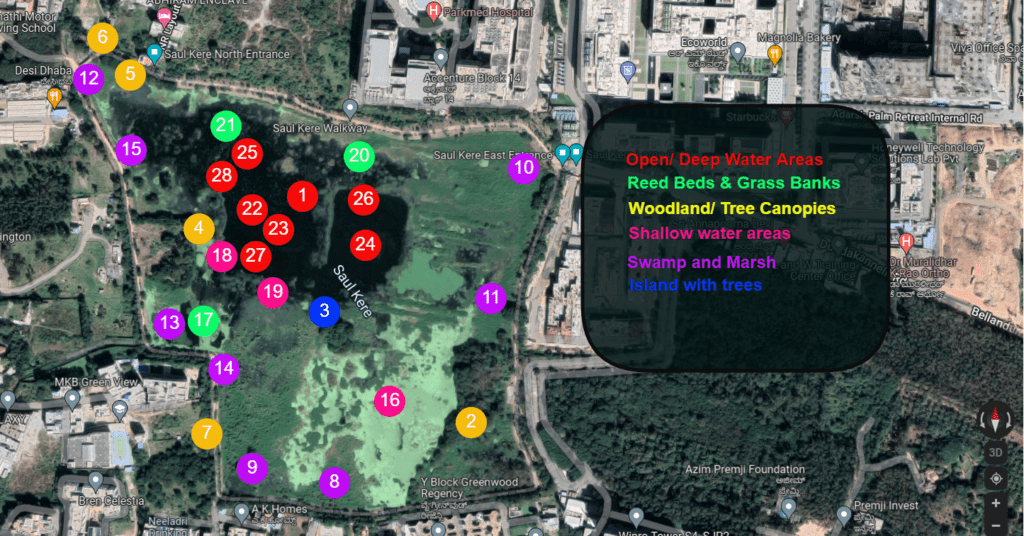
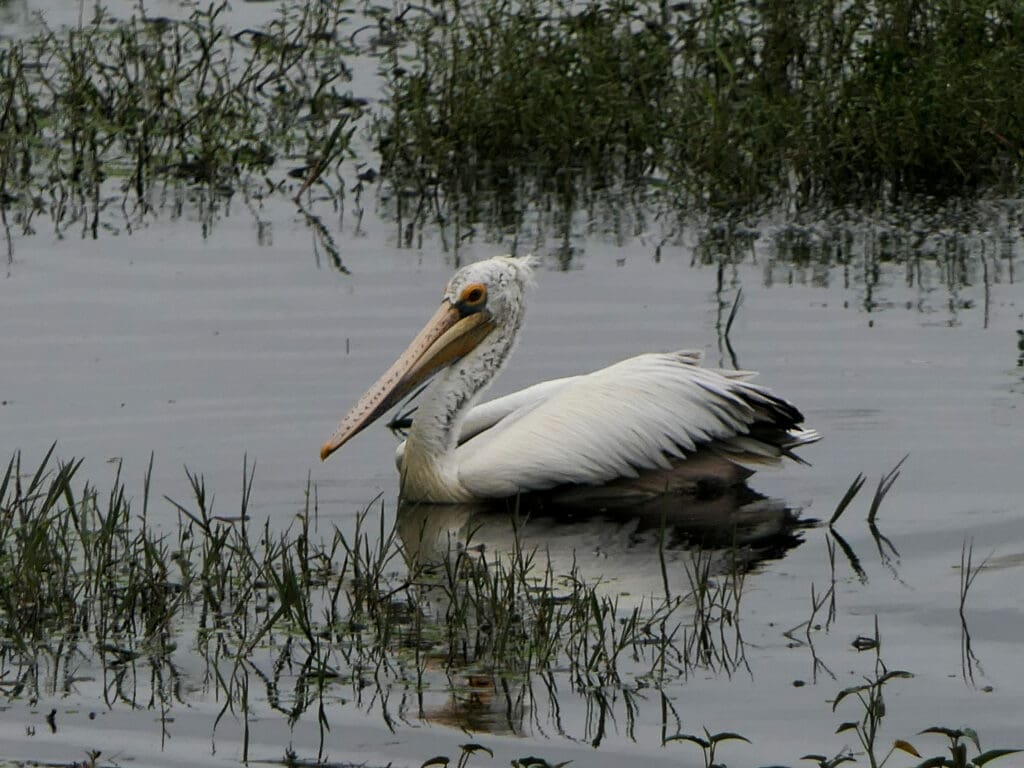

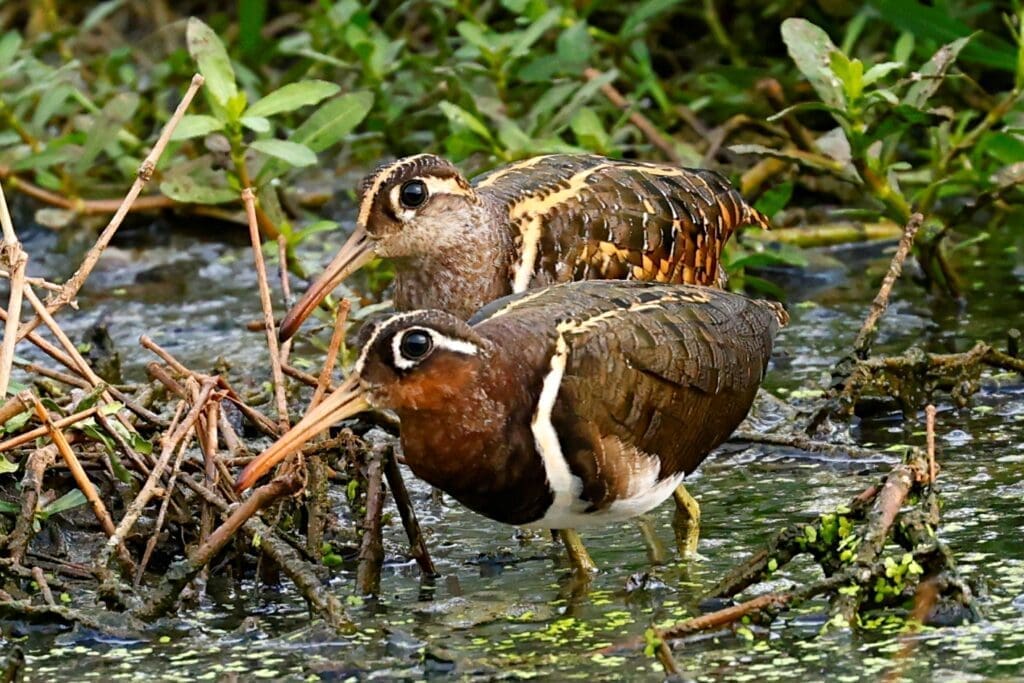
- Open-water zone: The open water zones are currently situated on the northern side of the lake. They are used by a variety of birds including Pelicans, Cormorants, Darters, Coots, Spot-billed Ducks, Northern Pintails, Northern Shovellers, Garganey, Little Grebes, Pied Kingfishers, White-throated Kingfishers, etc. They also constitute a potential habitat for diving ducks such as Common Pochards, which have not been recorded in the Bengaluru wetlands in a long time.
- The open water zone is interspersed with a tree-covered island, fashioned from soil (usually clay) excavated from the deepened lake bed. This offers nesting sites for Grey Herons, Purple Herons, Black-crowned Night-herons, Little Cormorants, Great Cormorants, and Intermediate Egrets. They also offer night roosting sites for starlings, mynas, Glossy Ibises, Black-headed Ibises and perches for Pelicans, Greater Spotted Eagles and other birds of prey.
- Birds like kingfishers, bee-eaters and hoopoes make nests in mud banks. Islands with mud walls, rather than stone walls, enable these birds to breed successfully. The recent State Of India’s Birds report shows a strong decline of Common Kingfishers owing to habitat loss. Since this species is observed time and again at Saul Kere, it is important to create suitable microhabitats for its continued breeding success.
- Reedbed & other vegetation zone: Besides supporting birds and other wildlife, reeds contribute to reducing alkali, salt and nitrates from the water, helping control erosion and restore the nutrient balance and the health of the ecosystem. Foreshore vegetation, such as reed-beds and submerged grassy slopes, are favoured by resident bird species such as Grey-headed Swamphens, Indian Spot-billed Ducks, Eurasian Moorhens, Eurasian Coots, and Little Grebes, which use the privacy of these sheltered nooks to raise their young. The reed-beds and swamps shelter secretive birds like Ruddy-breasted Crake, Baillon’s Crake, Cinnamon Bittern, Yellow Bittern and Greater Painted-Snipe. They also offer typical nesting sites for Black-breasted Weavers and Red Avadavats, as well as Zitting Cisticola and Pied Bushchats.
- Shallow-water zone: With a thin layer of floating vegetation and some emergent vegetation, the shallow water zones are suitable for dabbling ducks such as Spot-billed Ducks, Garganey, Northern Shovellers, Wigeon, Northern Pintail as well as Lesser Whistling Ducks, Eurasian Moorhens, etc.
- Water-edge or shoreline areas: With tall grass beds sloping down gradually towards the deep water, this habitat supports variable densities of seasonal vegetation. As the water level recedes at the end of winter, exposed mudflats invite flocks of Wood Sandpipers, Little Stints, Little Ringed Plovers and other shorebirds.
- Wet-mud and grassy meadow areas: These habitats become exposed as the water level recedes seasonally, and form suitable habitats for shorebirds and waders, such as Red-wattled Lapwings, Black-winged Stilts, Little Stints, Ruffs, Green Sandpipers, Common Snipe, Pintail Snipe, etc. Waders and shorebirds such as these favour shallow water and wet mud banks, probing for food like worms and crustaceans in the lake bed. Traditional lake layouts in Bengaluru allowed for such habitats to flourish. Grassy meadows are favoured by ducks such as Lesser Whistling-Duck, Spot-billed Duck as well as several species of wagtails, pipits, larks and other grassland birds.
- Woodland with understorey and shrubbery: These habitats are used by a variety of birds. The dense wooded patches have scattered trees and dense undergrowth. Situated on the southeast side of the lake, they have a nearly contiguous canopy cover with the adjoining wooded campus of Wipro Limited and the Azim Premji Foundation. In addition to common residents such as Ashy Woodswallows, barbets and parakeets, this woodland has played host to rare seasonal visitors like the White-naped Woodpecker, Eurasian Wryneck, Thick-billed Warbler and Lesser Cuckoo, the last documented as recently as November 2022, which benefit from the dense cover and isolation of the woodland areas and are often observed feeding on the abundance of insect prey that form part of their diet. Of special note is the fact that the dead trees in this ecosystem contribute as ideal nesting, roosting and feeding habitats for a variety of birds, besides providing aesthetic perches that have inspired thousands of excellent images made by photographers. The shrubbery, understorey and forest floor are suitable microhabitats that support various species of warblers, prinias, munias, tailorbirds and babblers.
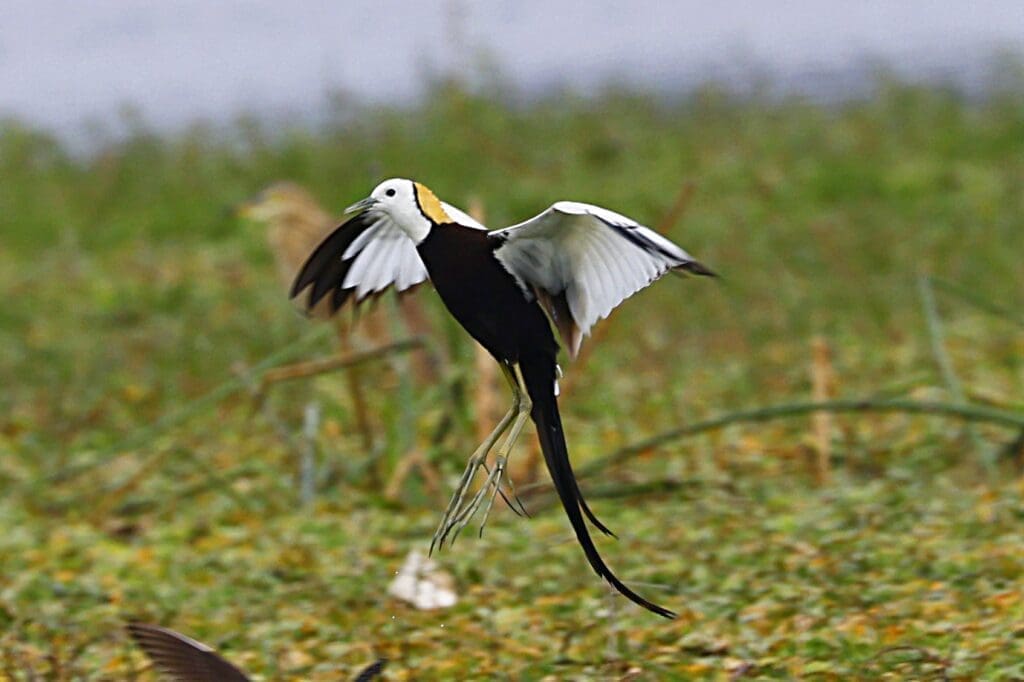
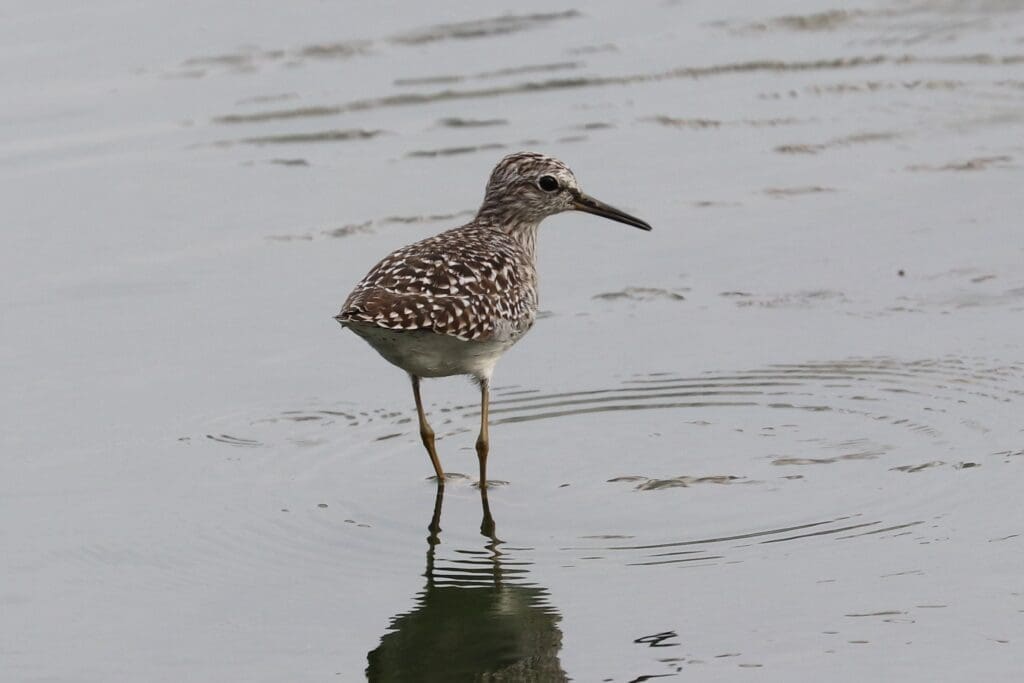

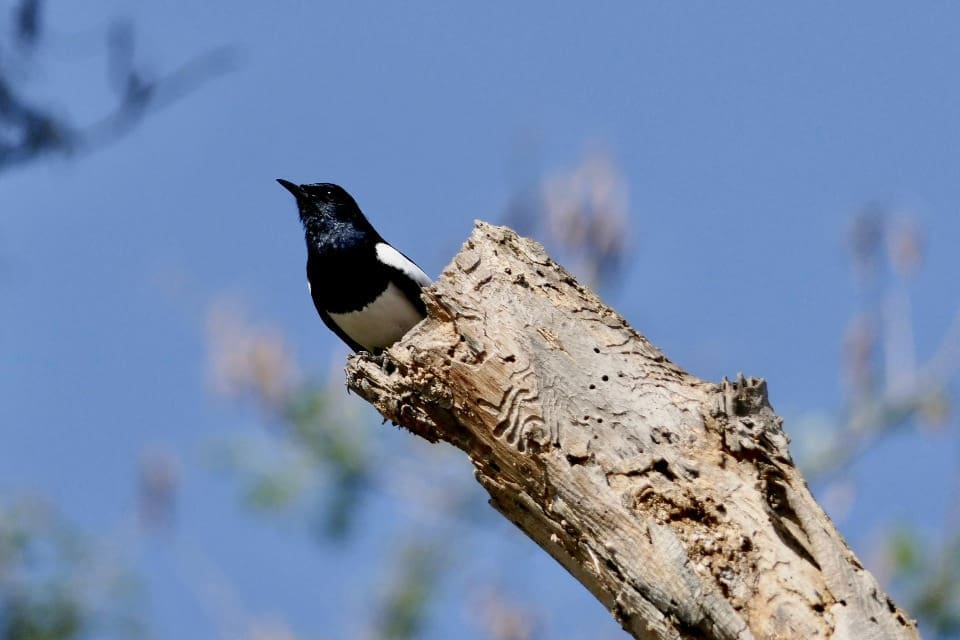
Environmental threats to Saul Kere
In recent years, Saul Kere has been threatened by encroachment of the lake boundaries and untreated sewage inflow, which heavily compromise the quality and health of these diverse habitats available for biodiversity to thrive. Encroachments around the water body from construction, violation of fence boundaries, and raw sewage from multiple inlets, have caused the lake bed to fill up with garbage and debris, obstructing natural drainage channels.

The decline in the quality of water at Kaikondrahalli Lake (Google Maps location), upstream and southwest of Saul Kere, is an additional threat. Besides reducing water-holding capacity, toxins from raw sewage have resulted in fish kills at this lake, and similar threats apply to Saul Kere.
Predation by feral dogs, pigs and cats is an additional threat to nesting ground birds at Saul Kere, although this is not as serious as at other wetlands owing to the relative isolation of some of the avian habitats from the walking tracks.
During the Bengaluru floods of September 2022, Saul Kere overflowed onto the Outer Ring Road, flooding basements of residential and commercial properties, and causing damage to automobiles, electrical equipment and property worth crores of rupees. BBMP responded to the mounting public pressure by announcing a plan to desilt Saul Kere.
A flex banner with the BBMP logo appeared at the eastern entrance of Saul Kere on December 17, 2022 declaring that ₹200 lakh (₹2 Cr) has been sanctioned for public works such as “desilting, pathway, water body fencing and other works”.
Experts have asserted time and again that desilting, dredging and de-weeding are expensive and unnecessary short-term fixes that do not address the root cause of flooding. A similar proposal to manage Saul Kere was initiated in 2015 but was not completed. The BBMP has a track record of using unscientific short-term approaches to managing Bengaluru’s lakes, which have had disastrous consequences for many of our lakes, turning them into “soup bowls.”

As of March 2023, JCB excavators have been deployed to rake the lake bed. The BBMP has been approached several times to consider the concerns and suggestions raised by citizens.
‘Soup Bowl’ design – a flawed approach to lake management
In a soup bowl design, steep walls are created around lakes with stone pitching and fences around the perimeters.
- Paved walkways are often created, which prevent proper seepage and percolation of rainwater and create constraints for soil-dependent insects such as ants, beetles and wasps, as well as earthworms, snails, and certain non-venomous reptiles such as Brahminy Blind Snakes. Exotic tree species are planted and gardens are maintained using water from the lake.
- Flawed island design is wasteful and expensive. Soil (usually clay) excavated from the deepened lake bed is used to construct islands and are often planted with trees. While islands offer suitable roosting habitats for birds, it is important to keep them isolated to prevent intrusion by humans or predation by feral dogs, cats and pigs. Scientific island design is vital for sustaining avian diversity in the lake and to create suitable habitats for bird species.
- Absence of shallow foreshores, vital for sustaining wading birds dependent on shallow water and mudflats, are absent in soup bowl lakes. Such a design compromises the habitats necessary to sustain biodiversity and are not welcoming to migratory shorebirds such as lapwings, sandpipers, stints, and plovers, which visit our lakes from distant Siberia and north-eastern Asia.
- Puddling, as in creating watertight zones, is not a viable solution. Water remains trapped in the lakes, giving an outwardly aesthetic appearance but offering little of value to biodiversity, particularly bird life.
Such elements contravene the traditional design of these seasonal wetlands, eliminating the gradual foreshore and vegetation around them.
Comparison of bird diversity at Saul Kere and other ‘soup bowl’ wetlands in the neighbourhood
| Lake, Tank or Wetland Commons | Bird Species Recorded (2022) | Bird Species recorded (All time including Historical) |
| Saul Kere (link) | 186 | 209 |
| Devarabisanahalli Kere (link) | 39 | 80 |
| Hebbal Kere (link) | 65 | 180 |
| Haralur Kere (link) | 42 | 92 |
| HSR Agara Kere (link) | 62 | 133 |
With the decline of habitat quality at our lakes, Bengaluru’s bird diversity has seen a dramatic collapse since the 1990’s, owing to changes in lake development approaches, which have compromised the available habitats for birds. The prevalent approaches to lake development have also compromised their utility and value as public commons, accessible to all people who use them.
A model for biodiversity-friendly lake development
Traditionally, wetlands have been used as public commons, available to the people who utilise them in various ways. Cowherds and goatherds would graze their livestock on the gomalas or grazing pastures on the grassy banks, fisherfolk would breed and harvest local fish, foragers would collect bio-resources including edible greens, freshwater crustaceans and vegetables. In addition, the lakes were used for recreation by humans, and for food and shelter by wildlife including birds. As recently as four decades ago, water at many of our urban lakes was clean enough to drink. Sadly, today, most of Bengaluru’s once-numerous lakes have been lost to rampant urbanisation and pollution, and what remains is under increasing threat of obliteration.
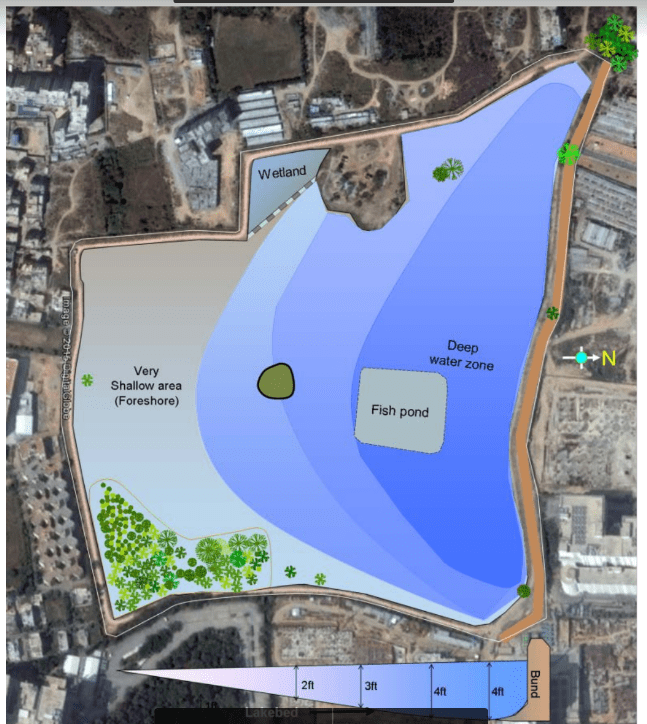
Above is a snapshot from a proposal made by senior ornithologist Dr S Subramanya in 2015 to create a balanced ecosystem that would benefit all communities including birds and other biodiversity. Dr Subramanya had proposed this plan in the capacity of an advisor to MAPSAS (Mahadevapura Parisara Samrakshane Mattu Abhivrudhi Samiti), a not-for-profit registered trust that was formed in 2011 to revive and rejuvenate lakes in the Bellandur Outer Ring Road/Sarjapur Road/Haralur Road areas.
Experts contend that the life of a lake, or tank as it is also known in common parlance, lies in its shallows. Scientist Dr M B Krishna proposes a departure from the soup bowl structure that has steep shorelines and stone pitching, which removes vegetation from the lake, besides making habitat unavailable for shorebirds such as sandpipers. Sewage water containing nitrates can lead to an algal bloom in the lake, reducing dissolved oxygen and causing large-scale fish kills as well as deaths of birds and other animals. Such alarming events have occurred at many lakes, including Kaikondrahalli, Kudlu and Haralur lakes, which are upstream from Sowl Kere. Denitrifying the lake is therefore an important priority for its continued health, and for this, it is necessary to grow plants around the water bodies to absorb nitrogen.
What can BBMP do better?

We strongly urge the authorities, including the Government of Karnataka and BBMP, to follow a consultative approach with citizen stakeholders to manage the lake, as follows:
- Public consultation and approval: Make public the plan for developing the lake, with details of expenditure and timelines of every stage of work, with public consultation at every step.
- Improved focus on biodiversity conservation. Although fresh water covers less than 1% of the planet’s surface, more than 50% of the human population lives within 3km of a freshwater body. The Living Planet Report 2022, the World Wildlife Fund’s flagship publication released every two years, is a comprehensive study of trends in global biodiversity and the health of the planet. It shows an average global decline of 69 per cent in wildlife populations since 1970, thus emphasising the dual crises of biodiversity loss and climate change driven by human activities. Given these criteria, it is important for the BBMP to adopt measures to secure the future of our wetlands and freshwater resources with a focus on conserving biodiversity at Saul Kere.
- Halt pollution through law enforcement: The Water (Prevention and Control of Pollution) Act, 1974 mandates that strict measures be enforced to stop pollution of water bodies. In this context, the inflow of raw untreated sewage into the wetland must be stopped and the perpetrators must face legal action. Sewage must be diverted around the water body without mixing with the lake water. Only treated water and rainwater/stormwater inflow into the lake must be allowed with suitable catchment nets to prevent garbage and debris from being deposited in the lake bed.
- Consult experts for ecological management of Saul Kere and other neighbouring wetland ecosystems: Consult with well-regarded ecologists and wetland management experts, in addition to birdwatchers and nature enthusiasts of the city who play a significant role in the stewardship of the lake, prior to initiating any development plan.
- Give primacy to wetland ecology for improving biodiversity: Ensure that an ecologically sound development plan is approved by these stakeholders and carried out, ensuring preservation of woodlands, swamps, grasslands, marshes, wetlands and sloping foreshore areas of the water body, in addition to a central deep water area, in order to provide suitable habitats for a variety of birds, including shorebirds, water birds, woodland birds, and grassland birds. One-third of the lake area should be occupied by floating vegetation, as it plays a vital role in bioremediation.
- Stone-pitching on the sides of Walking/Jogging Track: The sides of the Jogging track should have a very gradual slope (20-30 degrees) and the lower section of the stone-pitched slope should be covered in mud, as shown in the figure above. These slopes offer potential nesting sites for Bee-eaters, Hoopoes as well as Common Kingfishers and Pied Kingfishers, birds whose populations have seen a decline in recent years.
- Sloping of stone-lined edges should be at 1:7 not 1:1 or 1:3. The slope of the margin needs to be gentle and not steep, to suit the slope margin requirements of different birds.
- Slope ridging: Slopes should not be continuous; they should have furrows and ridges to hold plants perpendicular to the edge of the shore.
- No paved walkways: Paving the walkways does not allow water to seep into the ground effectively and is also disadvantageous to ants, wasps and other creatures that are dependent on soil. Instead of paved walkways, packed soil with gravel and sand are more effective and also friendly to walkers and joggers.
- Shoreline length: The length of the shoreline should be increased through interventions.
- Island design: Rather than construct circular islands, it is recommended that the islands be of a split-ring design with sloping as described above to accommodate the needs of bird species.
- Reduce wind turbulence over water by allowing growth of reeds and floating vegetation, which enable ripple-stopping.
- Bioremediation can take place only by encouraging plant growth. There is no effective cost-effective engineering solution to nitrogen removal other than plant growth in the lake.
- Control of invasive species: Ensure that invasive species of plants or animals (including exotic fish species) are not released or cultivated in the lake.
- Transparency of progress reports: Ensure that project progress and expenditure reports of the proposed development are announced transparently and approved by a representation of concerned citizens and carried out to completion.
- Clear encroachments on Raja Kaluve to prevent future flooding: Increase the current size/depth of untreated sewage diversion lines in order to avoid future inundation. The drain size adjacent to EcoSpace, in particular, must be widened to accommodate the excess outflow during periods of high rainfall.
- Public-private participation for maintenance and stewardship: Institute a citizen-led committee to maintain the wetland in a condition amenable for supporting biodiversity, with periodic testing and monitoring of water quality as well as vegetation and biodiversity surveys.
- Raise the height of the overflow weir by 1 foot to prevent incidental overflows and retain water in the lake catchment
“Without nature, we are nothing. Nature is our life-support system, and yet humanity seems hell bent on its destruction.”
António Guterres, UN Secretary-General, at the opening of the UN Convention on Biological Diversity (COP15) in Montréal, December 2022
Prepared with generous information input from Dr Subbu Subramanya, Dr M B Krishna, Garima Bhatia, Dr Gopi Sundar, Ulhas Anand, Ashwin Viswanathan, Dr Rajkamal Goswami, Chandra Sekhar Bandi, J N Prasad and Praveen Tangirala. Photographs used with kind permission of the owners.
- TL;DR – Death Stalks Like A Marabou Stork - July 24, 2024
- Dimorphic Egret – Meet this East African mystery bird - June 8, 2024
- Encounter: Northern Treeshrew in Arunachal Pradesh - May 19, 2024

It is good initiative taken, has a birder & nature lover we should stress the authorities to take a drastic step to re-cuppret the lake. I extend full suppourt for this. We will fight back in accordance to the nature & habitat
Comprehensive analysis and solution to the problem of soup bowl. Thank the team for a great effort.
Thank you, sir. Counting on your support to take this message forward.
Humans are forgetting that we all are part of the Mother Nature. As UN secretary General told we , greedy humans are destroying it. Hope and wish this initiative by Green Ogre will help in the rejuvenation of the lake.